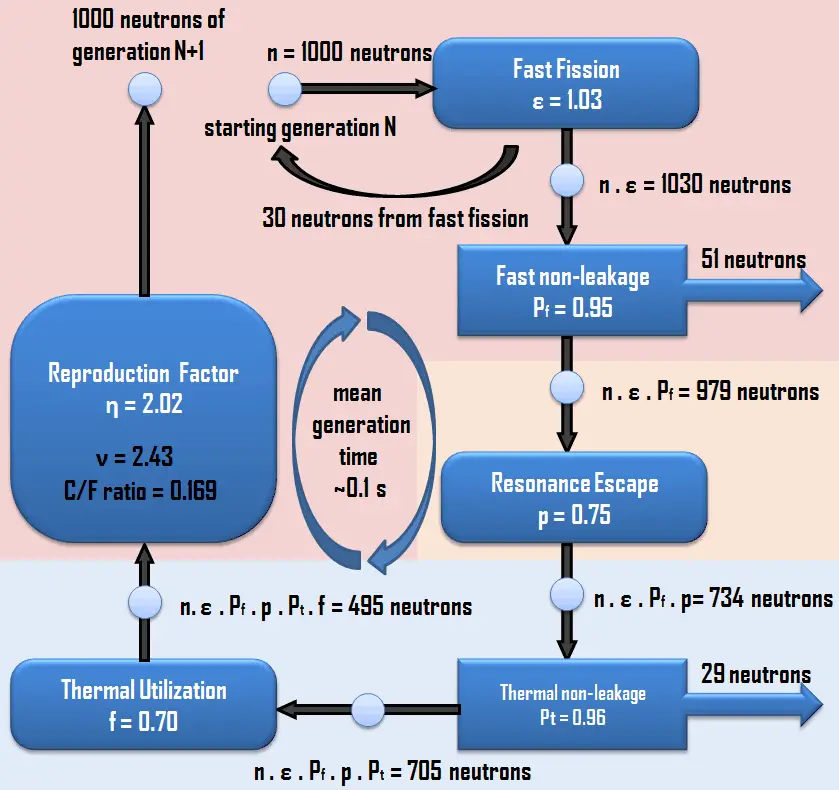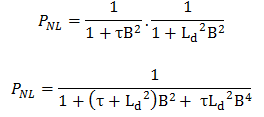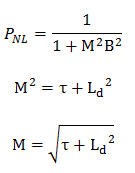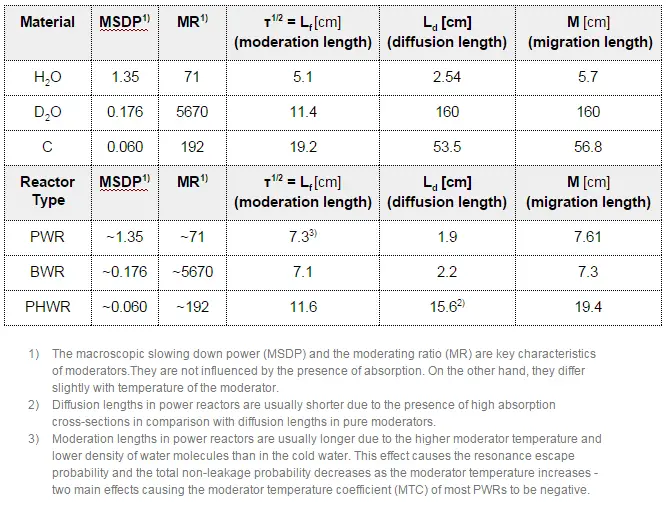In an infinite multiplication system, the leakage of the system is logically neglected. But all multiplying systems, all realistic reactor cores are finite multiplying systems, and the leakage may not be neglected. In general, neutrons may leak out of the system during:
- During the slowing down process, some of the neutrons leak out of the boundaries of the reactor core before they become thermalized. This process and its impact on the effective multiplying factor is characterized by the fast non-leakage factor, Pf, which is defined as the ratio of the number of fast neutrons that do not leak from the reactor core during the slowing down process to the number of fast neutrons produced by fissions at all energies.
-
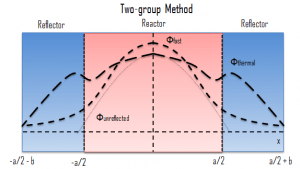
This figure shows the general effect of reflection in the thermal reactor system. Note that a reflector can raise the power density of the core-periphery and thus increase the core average power level without changing the peak power. During neutron diffusion, some of the neutrons leak out of the boundaries of the reactor core before they are absorbed. This process and its impact on the effective multiplying factor is characterized by the thermal non-leakage factor, Pt, defined as the ratio of the number of thermal neutrons that do not leak from the reactor core during the neutron diffusion process to the number of neutrons that reach thermal energies.
Total Non-leakage Probability
The fast non-leakage probability (Pf) and the thermal non-leakage probability (Pt) may be combined into one term that gives the fraction of all neutrons that do not leak out of the reactor core. This term is called the total non-leakage probability and is given the symbol PNL, and may be expressed by the following equation:
We can rewrite this equation without a substantial loss of accuracy for large reactors simply by replacing the diffusion length Ld and the fermi age τ with the migration length M in the one group equation. The term B4 is very small for large reactors, and therefore it can be neglected. We may then write.
where M is the migration area (m2), the migration length is defined as the square root of the migration area. As can be seen, the total non-leakage probability of large reactors is primarily a function of the migration area.
Neutron Reflectors – Leakage Reduction
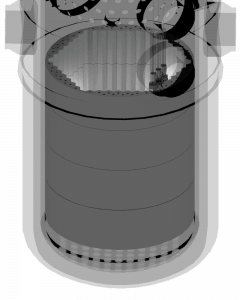
It is well known that each reactor core is surrounded by a neutron reflector or reactor core baffle. The reflector reduces the non-uniformity of the power distribution in the peripheral fuel assemblies, reduces neutron leakage, and reduces a coolant flow bypass of the core. The neutron reflector is a non-multiplying medium, whereas the reactor core is a multiplying medium.
Except for research reactors, practically all power reactor cores are designed to minimize neutron leakage. Neutron reflectors surround reactor cores to minimize leakage. The neutron reflector scatters back (or reflects) into the core many neutrons that would otherwise escape. By reducing neutron leakage, the reflector increases keff and reduces the amount of fuel necessary to maintain the reactor critical for a long period. In LWRs, the neutron reflector is installed for the following purposes:
- The neutron flux distribution is “flattened”, i.e., the ratio of the average flux to the maximum flux is increased. Therefore reflectors reduce the non-uniformity of the power distribution.
- Because of the higher flux at the edge of the core, there is much better utilization in the peripheral fuel assemblies. In the outer regions of the core, this fuel now contributes much more to the total power production.
- The neutron reflector scatters back (or reflects) into the core many neutrons that would otherwise escape. The neutrons reflected into the core are available for a chain reaction. This means that the minimum critical size of the reactor is reduced. Alternatively, if the core size is maintained, the reflector makes additional reactivity available for higher fuel burnup. The decrease in the critical size of the core required is known as reflector savings.
- Neutron reflectors reduce neutron leakage, i.e., to reduce the neutron fluence on a reactor pressure vessel.
- Neutron reflectors reduce a coolant flow bypass of a core.
- Neutron reflectors serve as a thermal and radiation shield of a reactor core.




